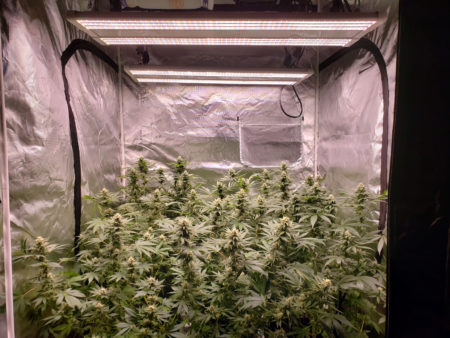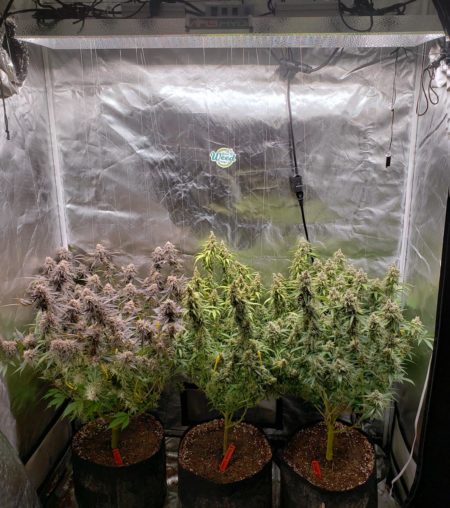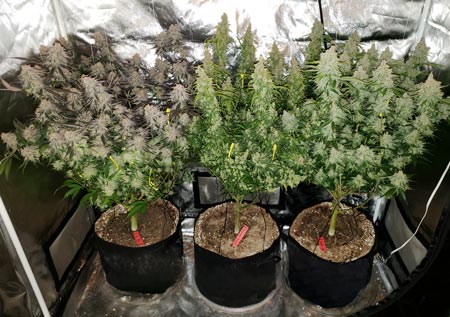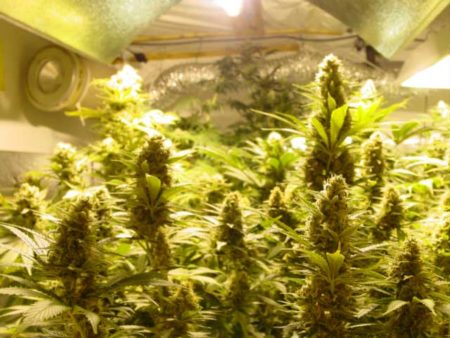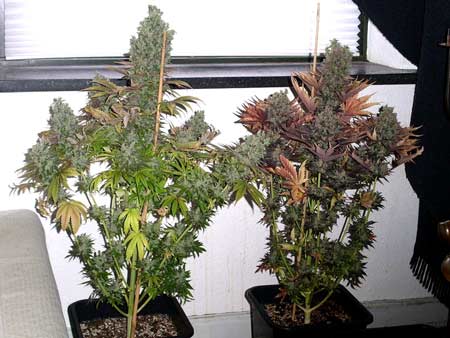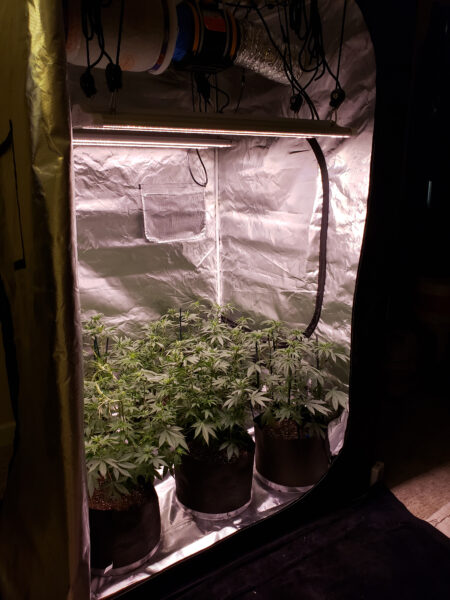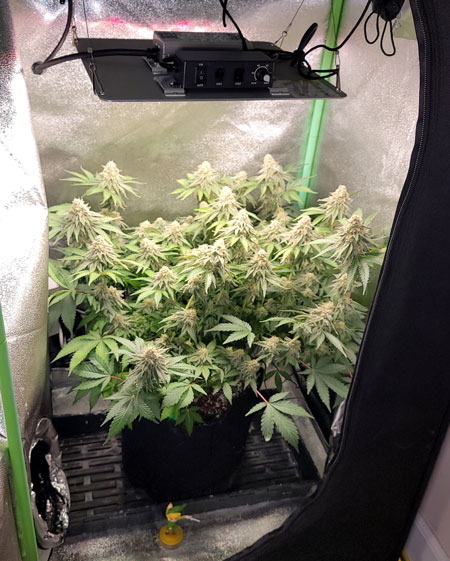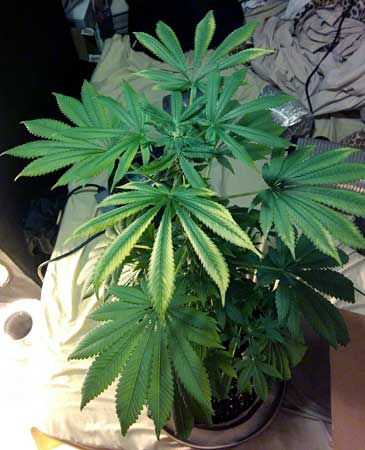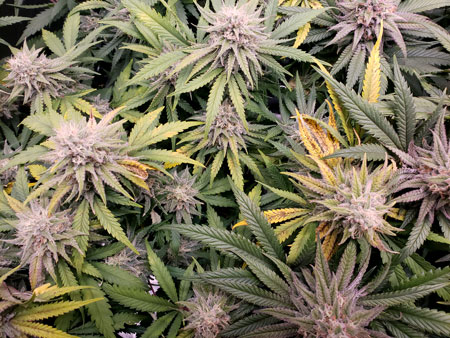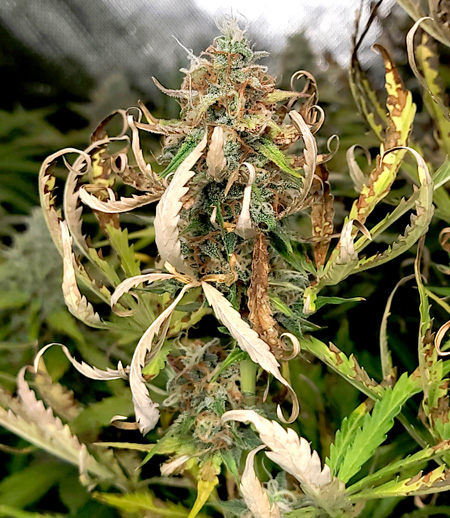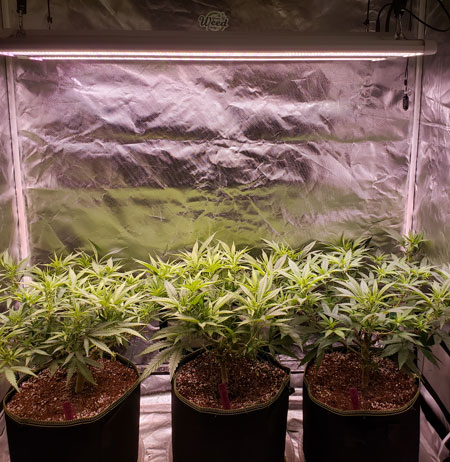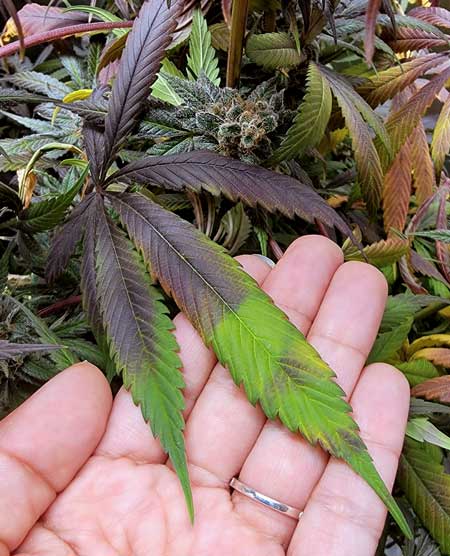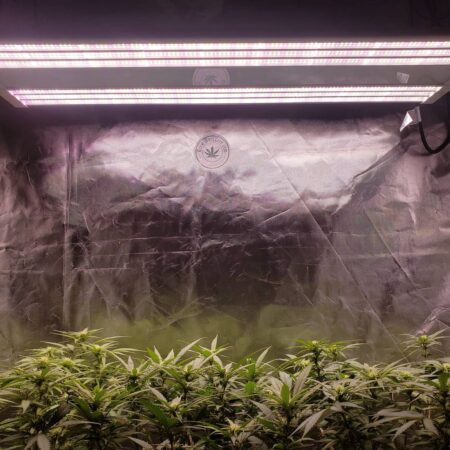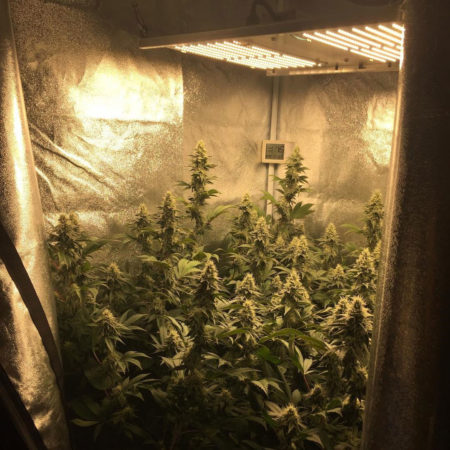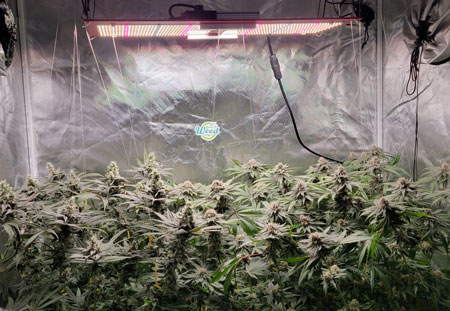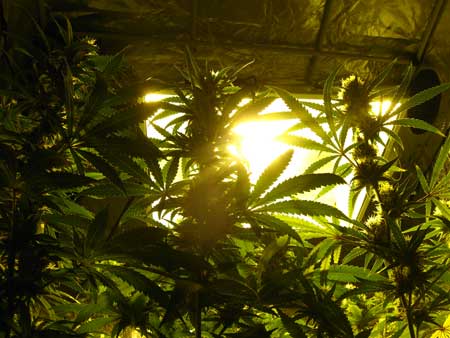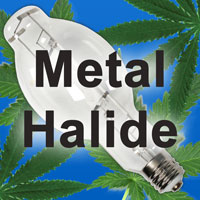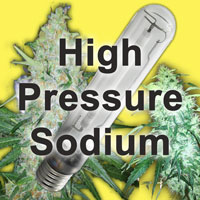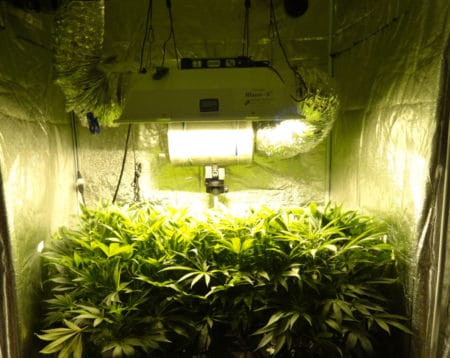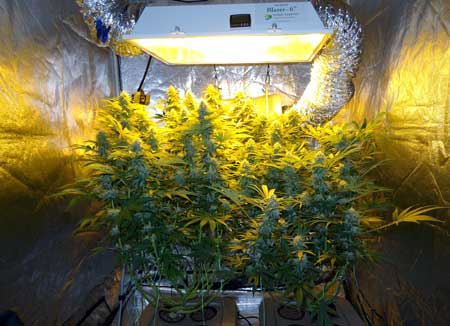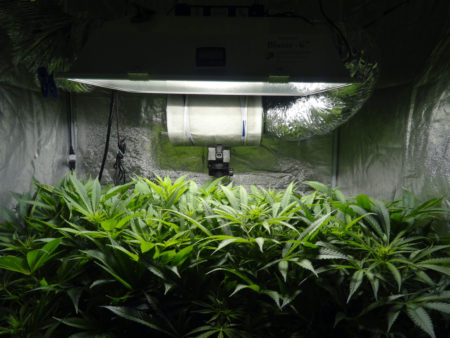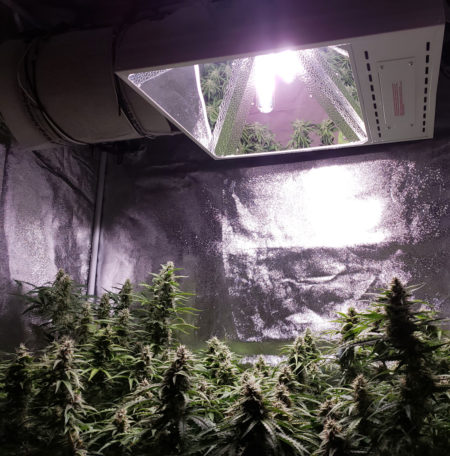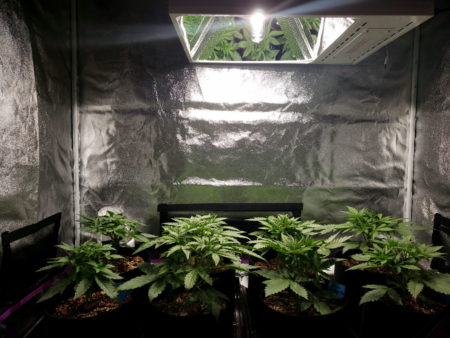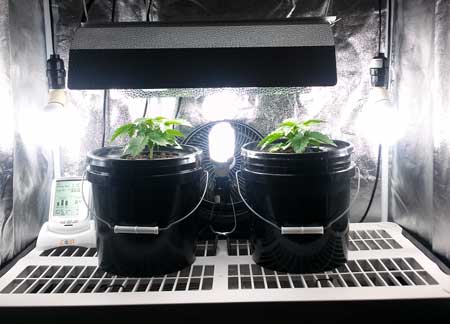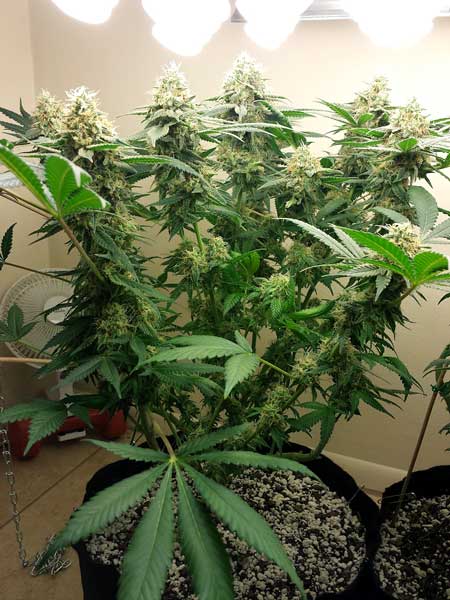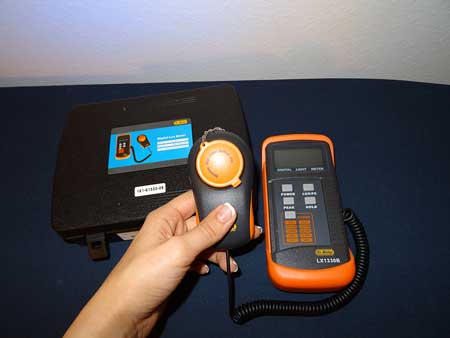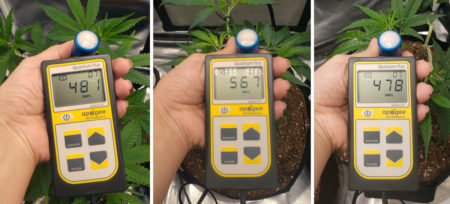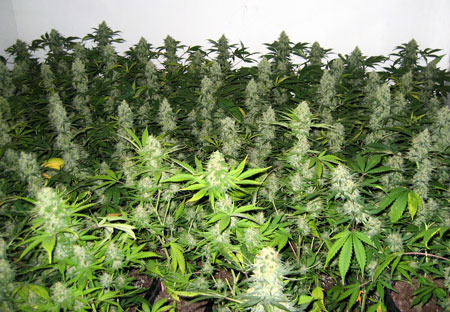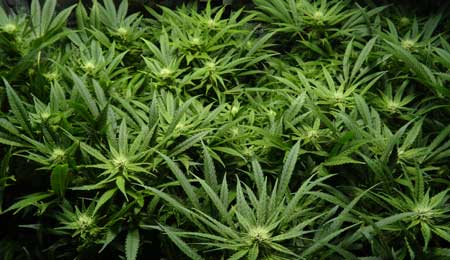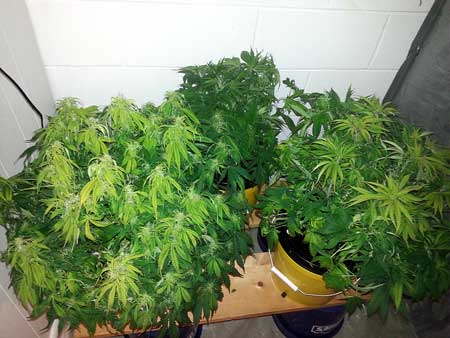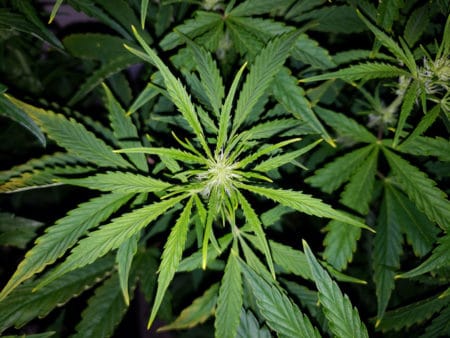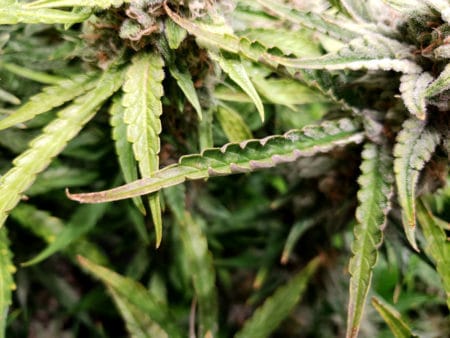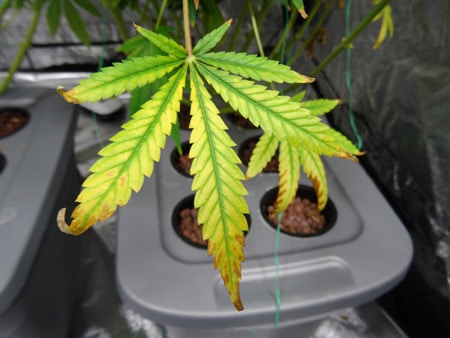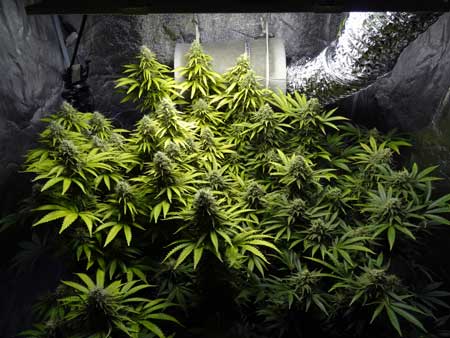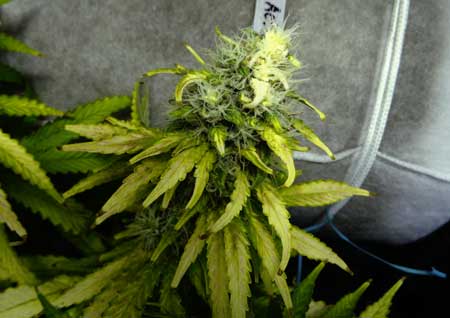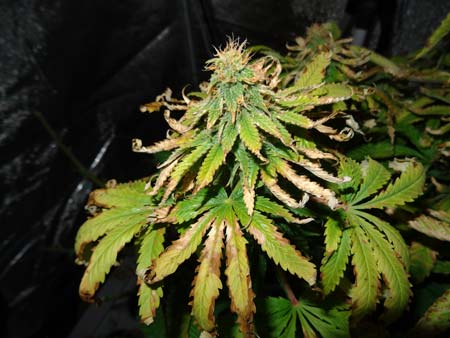by Nebula Haze
Table of Contents
Introduction: How Far to Keep Cannabis Grow Lights?
- LED Grow Lights ← Recommended
- MH & HPS Grow Lights
- LEC or CMH Grow Lights
- Fluorescent Grow Lights (T5s & CFLs)
Measuring Optimal Light Levels
How Far Away Should I Keep My Grow Lights?
Although this detail is sometimes overlooked, in many cases cannabis growers can increase their yields and potency simply by keeping their grow lights just the right distance from their plants.
How far away should you keep your grow lights for the best cannabis yields and potency?
Cannabis plants capture energy from light and use it to grow bigger buds. In order to maximize your cannabis yields you’ll want to give your plants as much light as possible, but without causing light burn. In other words, you want to increase light to max levels without going overboard.
Weak LEDs or fluorescent grow lights likely don’t produce enough light to overload your plants, but powerful lights like HPS, LECs, and LEDs can do so with ease. Although LED, LEC, and HPS grow lights can produce the biggest yields and most potent buds of all grow lights, they need to be used correctly to get great results.
Growers get bigger yields and more potent buds by using powerful grow lights and keeping them just the right distance away from marijuana plants.
Some grow lights perform best further away from plants than you might expect
Other grow lights should be kept much closer to get the best results
By positioning grow lights at the right distance from your plants, you’ll create the highest levels of light your cannabis plants can use. Put your cannabis buds in this “sweet spot” light level zone, and you’ll be rewarded with bigger denser buds and higher levels of THC.
Notice with these plants how all the top buds are big, while the lower buds are smaller. You want to keep grow lights close, because buds closest to the grow light get the biggest. (Do I need side lighting?)
More light is better when it comes to yields, but only up to a point. Although it may be tempting to keep trying to move grow lights closer and closer, your plants simply can’t use more light past a certain light level. Light is food for your plants, and leaves can only eat so much in a day before they start suffering from problems.
For example, if you keep grow lights too close to cannabis plants, you’ll see bleaching, yellow leaves, brown or burnt spots, and nutrient deficiencies. It’s important to find a balance. See symptoms of light stress below.
Each type of light needs to be kept a different distance away, so if you feel confused, this tutorial will show you how far to keep your grow light so you get incredible results every time, no matter what your setup.
LED Grow Lights
LED grow lights are the best grow light option for most home growers because they don’t use a ton of electricity, run relatively cool, and produce great yields and excellent bud quality when used correctly. But when growing cannabis with LED grow lights, it can be a little tricky to get the distance just right.
Unlike with MH/HPS/LEC grow lights, there is no “standard” distance to keep each LED grow light and it’s hard to summarize with a quick chart like the others. The distance needed between an LED and the top of the plant varies quite a bit from model to model and from manufacturer to manufacturer. Many things can affect the optimal distance from plants, including the individual size of each LED bulb, spacing of the diodes, and the way the manufacturer used lenses to reflect light downwards at your plants.
Different models of LEDs have different optimal distances. Bigger LED grow lights usually perform best when kept further away.
Smaller LEDs typically should be kept much closer
Check the recommended distance in the product details – Ultimately when it comes to LED grow lights, the best thing to do is contact the manufacturer or read the specifications to learn the recommended distance from the tops of plants.
If plants show signs of stress, keep LEDs further away until plants are growing healthy again – Although LED grow lights run cool, the LEDs available today give off an intense amount of light. High light intensity is great for yields and THC levels, but can give your plants light burn if the LEDs are kept too close even if the temperature is under control. Whenever you see signs of stress, move the LEDs further away until you see new healthy green leaves growing.
Keeping LEDs too close can give your plants a “Sunburn” even if the temperature is not too hot
If there is an environmental problem such as too much heat, overwatering, or if the plant is suffering from a nutrient deficiency due to incorrect pH at the roots, then you’re much more likely to see signs of stress on the leaves. Basically, your leaves can do less photosynthesis if the conditions aren’t ideal and start suffering when they get more light than they can process.
If there is some other problem, leaves can show light stress even if the LEDs are at the recommended distance away. This plant was the right distance from the LEDs but had too-low pH at the roots. Incorrect pH prevents proper nutrient absorption and caused many of the hard-working top leaves to turn brown and start dying. These symptoms may seem like light stress at first because it’s only affecting leaves close to the light. However, if the plant was getting proper pH and nutrients, it wouldn’t be showing these symptoms.
Another example of leaves under LEDs dying as a result of nutrient problems
If plants are really well taken care of (especially the right ratio of nutrients, comfortable environment, and proper pH at the roots), the same light may be able to move closer than the recommended distance without any signs of stress on the leaves, resulting in overall faster growth. For example, a HLG 350R LED grow light is a powerful 350W LED and is often recommended to be kept 24″ away. However, plants can thrive at just 18″ away if they get an excellent environment and the right nutrients.
Another common sight with LEDs is when the leaves close to the light turn purple. This is more like a sun tan than a sun burn. This picture shows how the part of the leaf that was covered by other leaves stayed green, while the parts of the leaf exposed to the LED turned purple.
Depending on the make and model, there’s a lot of difference in operating different LED grow lights, but if you weren’t given any instructions with the light, here’s a quick reference guide:
| Type of LED Grow Light | Distance From Plant |
| Under 100W | 10-14″ (25-35 cm) |
| 100-300W | 14-24″ (35-60 cm) |
| 300W-600W | 18-36+” (45-90+ cm) |
| 600W and bigger | 24-36+” (60-90+ cm) |
Start with the highest distance and slowly move the light down each day, or simply let plants grow up to the light.
Note: Some strains can handle more light than others. Better environment also lets plants use more light.
Powerful LED grow lights may need to be kept relatively far away from your plants to prevent light burn (especially if the conditions aren’t ideal).
Which LED grow lights are recommended for growing cannabis in 2022?
Metal Halide & HPS Grow Lights
HID grow lights like Metal Halide and HPS (High Pressure Sodium) were the most common grow lights for cannabis for decades. Until LED grow lights hit the cannabis growing scene. The original LED grow lights from the early 2000s couldn’t compete with MH/HPS but by 2020 the newest LEDs are better in almost every way for growing weed, especially in the home environment. LEDs use less electricity, produce less heat, and get comparable yields. However, MH/HPS are still widely used because 600W MH/HPS kits are much cheaper to buy than comparable wattage LEDs ($500 vs $1600 to start growing and produce 1 lb+) and get similar yields. However, since MH/HPS get hot and use more electricity, they are best suited to cooler grow climates with cheap electricity.
Metal Halide lights are well-suited to the vegetative stage and tend to encourage plants to grow short and squat though they are less electrically efficient than HPS. HPS lights are suitable for both the vegetative and flowering stage of cannabis growth and the light they give off encourages plants to quickly grow tall and produce big buds. Despite these differences, MH and HPS bulbs need to be kept about the same distance away from your plants. The proper distance actually depends on the size/wattage of your lamp.
Here’s a quick reference guide to use as a starting point:
| Grow Light | Closest | ~ Sunlight | Furthest |
| 150W | 8″ (20cm) | 10″ (25cm) | 12″ (30cm) |
| 250W | 10″ (25cm) | 12″ (30cm) | 14″ (35cm) |
| 400W | 12″ (30cm) | 14″ (35cm) | 19″ (48cm) |
| 600W | 14″ (35cm) | 16″ (41cm) | 25″ (64cm) |
| 1000W | 16″ (41cm) | 22″ (55cm) | 31″ (79cm) |
150W – covers 2′ x 2′ (0.6m x 0.6m) area
250W – covers 2′ x 2′ (0.6m x 0.6m) area up to 2.5′ x 2.5′ (0.8m x 0.8m)
400W – covers 3′ x 3′ (0.9m x 0.9m) area up to 3.5′ x 3.5′ (1m x 1m)
600W – covers 3.5′ x 3.5′ (1m x 1m) area up to 4′ x 4′ (1.2m x 1.2m)
1000W – covers 4′ x 4′ (1.2m x 1.2m) area up to 5′ x 5′ (1.5m x 1.5m)
With all grow lights, always do the “hand test” after you’ve positioned your light. If you put your hand where your plants are for 30 seconds, does it feel too hot for you? If so it may be too hot for the plants and the light should be moved a bit further away even if it’s already within the acceptable range.
A 600W HPS light should be kept about 16″ (40 cm) away from the tops of your plants
This grower didn’t keep moving the 600W HPS light up as plants got taller, and some colas on the left plant got within 12″ (30 cm) of the bulb. As a result, the top buds and leaves on that plant got burnt and/or bleached.
In addition to the wattage, it’s important to realize that older bulbs stop giving off as much light over time, so new MH/HPS bulbs generally need to be kept further away and older bulbs should be kept closer than the standard recommendations.
If you’re using new bulbs, never start closer than the “~Sunlight” distance on the chart, and only move lights closer if your plants are stretching towards the light (getting tall and lanky).
If you’re using older MH/HPS bulbs, you should replace them if you can, but if that’s not possible you can keep your bulbs closer to help make sure your plants are still getting good light levels. This is why it’s beneficial to be able to test your current light levels with a lux meter.
In general, MH bulbs need to be replaced about once a year (every 3 grows), while HPS grow lights last a bit longer, up to 2 years (every 4-5 grows). Older HID bulbs give off less light and more heat, so in addition to keeping the right distance, make sure you’re aware of the amount of time your bulbs have been used. To maximize the light to my plants in the flowering stage, I personally replace HPS bulbs every 3rd grow, but that’s a bit excessive.
If leaves are turned up toward the light, it’s a sign leaves are close to their upper limit for light. Any closer and they may get light burn damage on the leaves.
LEC/CMH Grow Lights
These lights are LEDs just like MH and HPS grow lights. In fact, they’re kind of halfway in between. They’re a Metal Halide light that uses ceramic like an HPS bulb, giving them the name “Ceramic Metal Halide” or “CMH”.
LEC stands for “Light Emitting Ceramic” and describes the same grow light technology. LEC grow lights are only sold by Sun System because the term “LEC” is trademarked. Sun System LECs only come in 315W and 630W sizes, as do most CMH lights. LEC lights usually have proprietary reflectors, while some CMH lights use more typical MH/HPS reflectors.
315W is the most popular size for LECs/CMH grow lights. An 315 LEC or 315 CMH grow lights should be kept 18-24″ from the top of your plants, with some models needing to be kept as far as 3 feet away.
CMH grow lights have been around for many years, and used to come in typical HID sizes like 400W, 600W and 1000W. Recently, they almost always come in 315W or 630W sizes so they can compete more directly with the branded LECs.
Learn more about LEC grow lights
When it comes to distance, LEC grow lights produce an extremely powerful light and typically need to be kept further away from your plants than HPS grow lights of a similar wattage. The proper distance varies wildly between models.
Sun System LEC Grow Lights
| LEC Grow Light Model | Distance From Plant |
| 315W | 18-24″ (45-60cm) or more |
| 630W | 24-30″ (60-75cm) or more |
Read an Indoor Grow Tutorial for the 315 LEC Grow Light
Other CMH models may need to be kept up to 3 feet away! Always read the instructions or ask the seller. Here are some examples I’ve found the distances for:
- Grower’s Choice 315W CMH – 2.5-3 feet (75-90 cm) from plants
- Hortilux 315W CMH – 3 feet (90 cm) from plants
- Vivosun 315 CMH – 24 inches (60 cm) from plants
*Keep LEC grow lights an extra 6-12″ (15-30cm) away for young plants, or if you see signs of leaf stress. If you’re noticing symptoms on just the tops of the plants closest to the light, as opposed to evenly on all the leaves, the problem may be that the light is too close, even if it looks like a nutrient deficiency!
Same as with MH/HPS grow lights, always conduct the 30-second “hand test” after you’ve positioned your light. If the light bothers your hand after 30 seconds, it may bother your plants!
LEC grow lights are surprisingly powerful and must be used cautiously to prevent light burn, especially with seedlings and strains that tend to be more sensitive to light. This 315 LEC is being kept 2.5 feet (75 cm) away from the tops of these young plants until they get bigger. Some CMH models need to be kept 3 feet away from the tops of plants.
LEC bulbs last longer than either MH or HPS grow lights and only need to be replaced every 6-7 grows.
Fluorescent Grow Lights (like CFLs & T5s)
LED grow lights produce 2-4x greater yields per watt than fluorescent grow lights for cannabis, so you should probably get a small LED as opposed to any kind of fluorescent lighting. But I wanted to include a small amount of information here in case you happen to be using one for some reason.
As long as it’s not too hot, you basically can’t give your cannabis too much light with these types of grow lights. Fluorescent lights like T5s and CFLs typically can’t produce enough light to cause “light burn” the way you get with the other, more powerful lights. So the idea is to keep your plants as close as possible as long as the distance passes the “hand test.” You know your lights are a good distance away as long as you can put your hand where your plants are for 30 seconds and it doesn’t feel too hot for you. Just make sure to give enough extra space for fast-growing plants because the heat can hurt them if they grow into the lights.
Keep Fluorescent Grow Lights As Close As You Can to Cannabis Plants Without It Getting Too Hot.
With fluorescent grow lights, it becomes especially important to learn how to use plant training techniques. You will need to train your plants in order to achieve an even canopy and get good harvests. But with good training, you can grow cannabis under CFL grow lights that look like this!
Or T5 fluorescent lights to grow cannabis like this!
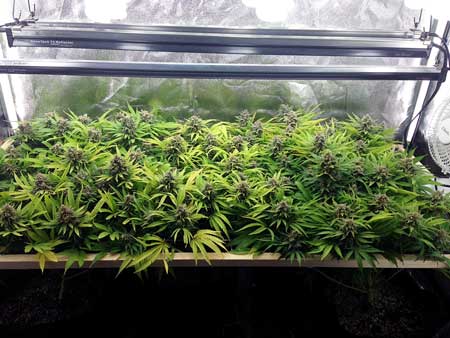
Measuring Optimal Cannabis Light Levels

However, a lux meter is accurate enough for indoor cannabis gardening when it comes to fluorescent, CFL, MH, and HPS grow lights. It also helps give you information when using LED grow lights.
Quick Guide – Lux Levels for Optimal Cannabis Growth
| Life Stage | Maximum | Good | Minimum |
| Vegetative | 70,000 lux | 40,000 lux | 15,000 lux |
| Flowering | 85,000 lux | 60,000 lux | 35,000 lux |
< 15,000 lux – sparse or “stretchy” growth – plant isn’t getting enough light
15,000 – 50,000 lux – good amount of light for healthy vegetative growth
45,000 – 70,000 lux – optimal amount of light for cannabis plants in the flowering (budding) stage
70,000 – 85,000 lux – a lot of light, some strains thrive at this light level, but some plants (especially auto-flowering and indica strains) lose their top leaves early under this light intensity and need lights to be kept further away for healthy growth. The better the environment and healthier the leaves, the more light the plant can take.
> 85,000 lux – at this light intensity, you’ve hit most cannabis plants’ “saturation point” which means your plant can’t use all the light (be careful of light bleaching).
Note: Excellent environment, healthy leaves, good care, certain genetics, and or CO2 supplementation can allow your plants to use more light.
Learn more about using lux meters to increase yields
Note: Unfortunately, a lux meter may not be a good tool for estimating the brightness of LED grow lights by comparing to that table. Lux meters have been calibrated to be accurate for incandescent light bulbs. Although this is close enough to fluorescent and some HID lights that it doesn’t make a huge difference to your plants, the unique color spectrum of LED grow lights doesn’t always translate well when the lux meter is trying to measure light levels. Therefore, go by what your plants are telling you vs the lux meter. If plants look stressed, move the light further away.
PAR and ePAR Meters
PAR stands for Photosynthetically Active Radiation and stands for the spectrum of light/radiation that can be used by plants for photosynthesis. Typically PAR is defined as the light spectrum between 400 to 700 nanometers. You’ve probably seen a light spectrum PAR chart before.
PAR Chart
A “PAR meter” directly measures how much light is being delivered in this range. This is more accurate than a lux meter, because a lux meter is designed to measure the light humans can see with our eyes, while a PAR meter measures how much light the plant can use for photosynthesis.
Newer research by NASA and cannabis growers has shown that plants can actually photosynthesize light in the 700-750nm (far red) range, too. That’s why new PAR meters measure between the range of 400-750nm and are called “ePAR” meters.
ePAR meters measure between 400-750nm, which is the known spectra of light that cannabis plants can use for photosynthesis. Apogee Instruments MQ-610 is one of the best ePAR meters, but costs almost $600. Definitely for the dedicated grow scientist. But I have to admit, an Apogee light meter is really fun and interesting to use. Here’s how the light levels differed in one tent at different places under a Spider Farmer SF-2000 LED grow light.
PAR and ePAR meters are expensive, and unnecessary to get great results growing weed. Even with a PAR meter, you still need to look at your plants and try to keep lights as close as possible without light stress. Your plants may be able to use more or less light than expected. PAR meters are good for helping you record the light levels for future reference, and see how light levels change throughout your grow space, but not as good for telling you “keep your grow lights at this particular level” because that changes a lot from plant to plant and environment to environment.
Increase Marijuana Yields Even More With Training!
Tip: In addition to knowing the right distance to keep your grow lights, many cannabis growers can increase their yields even more by using plant training to take advantage of that “sweet spot” where plants are getting the best amount of light. Training plants to grow with many colas of the same height (like the cannabis plants pictured below) allows dozens of buds to be the same distance from the grow light, so all the buds can be in the sweet spot at the same time!
Get many colas close to the light for the best yields!
Signs of Cannabis Light Stress
Here are some examples of light stress appearing on the parts of the plant closest to the light. Learn more about light stress.
If the leaves start pointing up like this, it’s a sign the plant is getting a LOT of light. Some growers like to see their leaves “pray” but this is a sign that your leaves are close to their upper limit for light. If you see this keep a close eye to make sure leaves don’t start turning yellow early.
Keeping grow lights too close hurts your plants. These plants were too close to their LED grow lights for too long, and their top leaves started getting bleached from light burn. The plants were more susceptible because they were also suffering from overwatering. Sick or unhealthy plants are much more likely to get stressed from the grow light because leaves can’t work as hard.
Sometimes the tips of leaves will turn yellow in response to the grow light being too close. This is different from nutrient burn which produces brown tips, or nutrient deficiencies which typically appear all over the plant and are often caused by incorrect pH at the roots.
Edges of leaves may turn up from light stress. If it goes on too long, the leaves will eventually get crispy or brittle, and you can easily break them off by touching the leaves.
Closeup of yellow leaf from light stress
Light Stress on Leaves – Notice how the leaves closer to the light have turned yellow, while the leaves further from the light are still green. This is a sign the plant is experiencing light stress and the grow light should be moved up.
Light Bleaching – Although it was a comfortable temperature in the grow space, the grow light was too close, which caused the yellow leaves and bleaching on the buds
Learn more about cannabis light burn and other types of light stress
Jump to…
Compare Different Cannabis Grow Lights: Review
Beginner’s Guide to Growing Weed
Cannabis Problems & Leaf Symptoms

